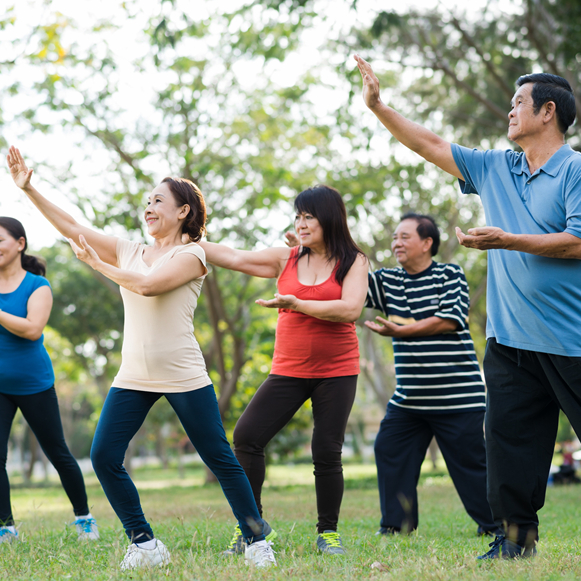
Tai chi
Alternative names: Art Martial Interne, Internal Martial Art, Méditation en Mouvement, Moving Meditation, Tai-Chi, Tai Chi Chih, Tai Chi Chuan, Tai Chi Martial Arts, Taichi Quan, Tai Ji Quan, Taiji, Taijiquan, Tie Chee
Background
Tai chi is a Chinese martial art originally developed for self-defense. It consists of exercise, breathing, and meditation. It is a form of Qi gong.
Tai chi is an exercise of low-to-moderate intensity. It might help prevent falls in some older adults by reducing their fear of falling and improving their balance and muscle strength.
People use tai chi for athletic performance, preventing falls, back pain, obesity, diabetes, depression, and many other conditions, but there is no good scientific evidence to support many of these uses.
Don't confuse tai chi with Qi gong. Tai chi is a specific type of Qi gong.
Tai chi is an exercise of low-to-moderate intensity. It might help prevent falls in some older adults by reducing their fear of falling and improving their balance and muscle strength.
People use tai chi for athletic performance, preventing falls, back pain, obesity, diabetes, depression, and many other conditions, but there is no good scientific evidence to support many of these uses.
Don't confuse tai chi with Qi gong. Tai chi is a specific type of Qi gong.
Safety Safety definitions
Tai chi is likely safe when practiced appropriately. There are no known safety concerns or serious side effects.
Special Precautions & Warnings:
Pregnancy and breast-feeding: There isn't enough information to know whether tai chi is safe when pregnant or breast-feeding. If you are pregnant or breast-feeding, check with your healthcare provider before starting tai chi or any other exercise program.Effectiveness
NatMed Pro rates effectiveness based on scientific evidence according to the following scale: Effective, Likely Effective, Possibly Effective, Possibly Ineffective, Likely Ineffective, Ineffective, and Insufficient Evidence to Rate.
Possibly effective Effectiveness definitions
- Athletic performance. Practicing tai chi seems to improve fitness levels, particularly in older adults who don't often exercise.
- Back pain. Practicing tai chi somewhat reduces low back pain in people with chronic low back pain.
- A lung disease that makes it harder to breathe (chronic obstructive pulmonary disease or COPD). Practicing tai chi seems to help people with COPD walk farther. Tai chi might also improve lung function in people with this condition.
- Fall prevention. Practicing tai chi seems to help prevent falls in older adults, especially when practiced regularly. Yang style tai chi and a type of tai chi specifically tailored for fall prevention seem to help the most.
- Fibromyalgia. Practicing tai chi seems to improve symptoms of fibromyalgia by a small amount. It seems to work as well as exercise for improving function and pain.
- Heart failure. Practicing tai chi helps people with heart failure walk farther.
- High blood pressure. Practicing tai chi reduces blood pressure in people with high blood pressure by about the same amount as general exercise.
- Insomnia. Tai chi seems to improve the quality and length of sleep in people with sleep complaints and older people with chronic insomnia.
- Obesity. Practicing tai chi reduces waist size and bodyweight in overweight and obese people.
- Osteoarthritis. Practicing tai chi seems to improve function, stiffness, and pain in people with osteoarthritis.
- Physical performance. Practicing tai chi improves how inactive elderly people feel about their physical function. This includes their ability to get around without help. But it's not clear if it helps other measurements of physical performance.
Dosing & administration
Tai chi is usually practiced for an hour daily, 1-5 times weekly. There are many different styles of tai chi. Some styles may be better for certain conditions. For example, Yang style tai chi appears to work better than Sun style tai chi for fall prevention.
Tai chi is not regulated in any way and there are no specific standards for training. Practitioners of tai chi are not considered health professionals in North America. However, in China, tai chi is often practiced along with conventional modern medicine.
Tai chi is not regulated in any way and there are no specific standards for training. Practitioners of tai chi are not considered health professionals in North America. However, in China, tai chi is often practiced along with conventional modern medicine.
Interactions with pharmaceuticals
It is not known if this treatment interacts with any medicines. Before using this treatment, talk with your health professional if you take any medications.
Interactions with herbs & supplements
There are no known interactions with herbs and supplements.
Interactions with foods
There are no known interactions with foods.
vital.ly has licensed monographs from TRC Healthcare.
This monograph was last reviewed on 16/01/2025 11:00:00 and last updated on 10/04/2022 09:34:50. Monographs are reviewed and/or updated multiple times per month and at least once per year.
Natural Medicines disclaims any responsibility related to medical consequences of using any medical product. Effort is made to ensure that the information contained in this monograph is accurate at the time it was published. Consumers and medical professionals who consult this monograph are cautioned that any medical or product related decision is the sole responsibility of the consumer and/or the health care professional. A legal License Agreement sets limitations on downloading, storing, or printing content from this Database. No reproduction of this monograph or any content from this Database is permitted without written permission from the publisher. It is unlawful to download, store, or distribute content from this site.


